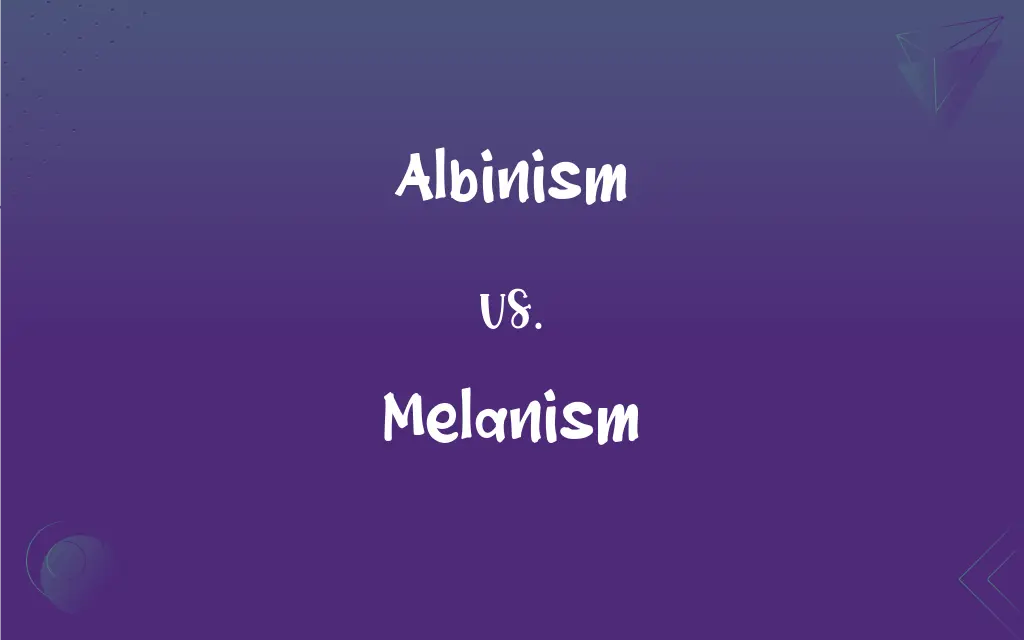Albinism vs. Melanism: What's the Difference?
Edited by Aimie Carlson || By Janet White || Published on February 9, 2024
Albinism is a genetic condition causing a lack of melanin, resulting in white or pale skin, hair, and eyes. Melanism is a genetic condition leading to an excess of melanin, causing dark pigmentation in skin, hair, or feathers.

Key Differences
Albinism is characterized by a deficiency or absence of melanin pigment in the skin, hair, and eyes, often resulting in very light coloring. Melanism, on the other hand, is the opposite condition where there is an overproduction of melanin, leading to darker coloration than typically seen in the individual's species.
Individuals with albinism often have very pale skin, white or light-colored hair, and may have vision problems due to the lack of pigment in the eyes. Melanistic individuals exhibit a high degree of pigmentation, resulting in black or very dark coloring in skin, feathers, or fur.
Albinism is caused by mutations in various genes that affect melanin production, leading to a total or partial lack of this pigment. Melanism results from different genetic mutations that lead to increased melanin production or distribution.
Albinos, both human and animal, may face challenges like increased susceptibility to sunburn and skin cancers due to lack of protective melanin. Melanism can offer advantages such as enhanced camouflage or heat absorption, but it can also lead to overheating or increased predation risk in some environments.
Albinism is often associated with certain health issues, particularly related to vision, as melanin plays a key role in the development of optical systems. In contrast, melanism generally does not have associated health issues, although it can affect an individual's visibility and interactions within their species and environment.
ADVERTISEMENT
Comparison Chart
Melanin Production
Lack or absence of melanin
Excess production of melanin
Visual Characteristics
Pale or white skin, hair, and eyes
Dark or black skin, hair, feathers, or fur
Genetic Cause
Mutations causing deficient melanin production
Mutations leading to increased melanin production
Associated Health Issues
Increased sun sensitivity, vision problems
Usually no direct health issues, but can affect camouflage
Adaptive Significance
Often disadvantageous due to visibility and sensitivity
Can be advantageous for camouflage or heat absorption
ADVERTISEMENT
Albinism and Melanism Definitions
Albinism
A condition marked by a complete or partial lack of melanin pigment.
The albino rabbit had white fur and red eyes, characteristic of albinism.
Melanism
The genetic trait of having a high degree of pigmentation.
Melanism is often observed in birds, providing a distinct contrast to their usual coloration.
Albinism
A hereditary condition resulting in little to no pigment in an individual.
Albinism in humans is rare and involves both skin and visual abnormalities.
Melanism
An adaptation characterized by darkened skin, feathers, or fur.
Melanism can provide better camouflage in certain environments.
Albinism
A genetic disorder causing reduced or absent melanin production.
People with albinism often need to take extra care in the sun due to their sensitivity.
Melanism
An increased melanin production leading to dark pigmentation.
The panther, known for its melanism, had strikingly dark fur.
Albinism
The absence of color in skin, hair, and eyes due to a melanin deficiency.
Albinism is noticeable in animals like albino peacocks, which have white feathers instead of colorful ones.
Melanism
A genetic variation resulting in a black or dark appearance in animals.
Melanism in leopards results in the black panther, a melanistic variant of the species.
Albinism
A condition characterized by white or pale appearance due to lack of melanin.
The child's albinism was evident in her very light hair and skin tone.
Melanism
A condition where excess melanin causes unusually dark coloration.
The snake exhibited melanism, making it almost entirely black.
Albinism
Any of several inherited conditions characterized by the reduction or absence of the pigment melanin in a person or animal, resulting in lack of pigmentation in the eyes, skin, and hair. Humans with albinism usually have vision problems.
Melanism
See melanosis.
Albinism
Lack of chlorophyll in a plant or plant part, resulting in a pale color.
Melanism
Dark coloration of the skin, hair, fur, or feathers because of a high concentration of melanin.
Albinism
Congenital lack of melanin pigmentation in the skin, eyes, and hair or feathers (or more rarely only in the eyes); the condition of being albino.
Melanism
Congenital excess of melanin pigmentation in the skin, hair, feathers and/or eyes.
Albinism
The state or condition of being an albino: abinoism; leucopathy.
Melanism
An undue development of dark-colored pigment in the skin or its appendages; - the opposite of albinism.
Albinism
The congenital absence of pigmentation in the eyes and skin and hair
Melanism
A disease; black jaundice. See Melæna.
Melanism
The character of having a high degree of pigmentation, as shown in dark skin, eyes, and hair.
Melanism
A condition characterized by abnormal deposits of melanin (especially in the skin)
FAQs
What causes albinism?
Genetic mutations that lead to reduced or absent melanin production.
Is melanism common in animals?
It's less common than typical pigmentation but occurs in several species.
How is melanism different from albinism?
Melanism is characterized by excess melanin causing dark pigmentation, unlike the lack of melanin in albinism.
Can albinism affect vision?
Yes, albinism often affects vision due to the lack of pigment in the optical system.
Do people with albinism have health issues?
They are prone to skin and vision problems due to the lack of melanin.
What species are known for melanism?
Species like the black panther, a melanistic variant of leopards, are well-known.
How does melanism affect survival in the wild?
It can enhance survival in darker environments but may be a disadvantage in lighter ones.
What advantages does melanism provide?
It can offer better camouflage and heat absorption in certain environments.
Are albino individuals always completely white?
Most have very pale skin and hair, but some may have slight pigmentation.
Does melanism affect an animal's behavior?
It can influence their interactions and camouflage strategies.
Is melanism a dominant or recessive trait?
It can be either, depending on the specific genetic mutation.
Can melanism occur in plants?
Rarely, as melanism primarily affects animals.
Is albinism hereditary?
Yes, it's a genetic condition passed down through families.
Are albino animals more prone to predation?
Yes, due to their lack of camouflage and visibility.
What precautions do people with albinism need to take?
They need to protect their skin and eyes from the sun.
Can albinism be treated or cured?
There's no cure, but symptoms like vision problems and skin sensitivity can be managed.
Do all albino individuals have red eyes?
Not always; some may have light blue or green eyes.
Can melanism be observed in domestic animals?
Yes, it occurs in domestic animals like cats and dogs.
About Author
Written by
Janet WhiteJanet White has been an esteemed writer and blogger for Difference Wiki. Holding a Master's degree in Science and Medical Journalism from the prestigious Boston University, she has consistently demonstrated her expertise and passion for her field. When she's not immersed in her work, Janet relishes her time exercising, delving into a good book, and cherishing moments with friends and family.
Edited by
Aimie CarlsonAimie Carlson, holding a master's degree in English literature, is a fervent English language enthusiast. She lends her writing talents to Difference Wiki, a prominent website that specializes in comparisons, offering readers insightful analyses that both captivate and inform.







































































